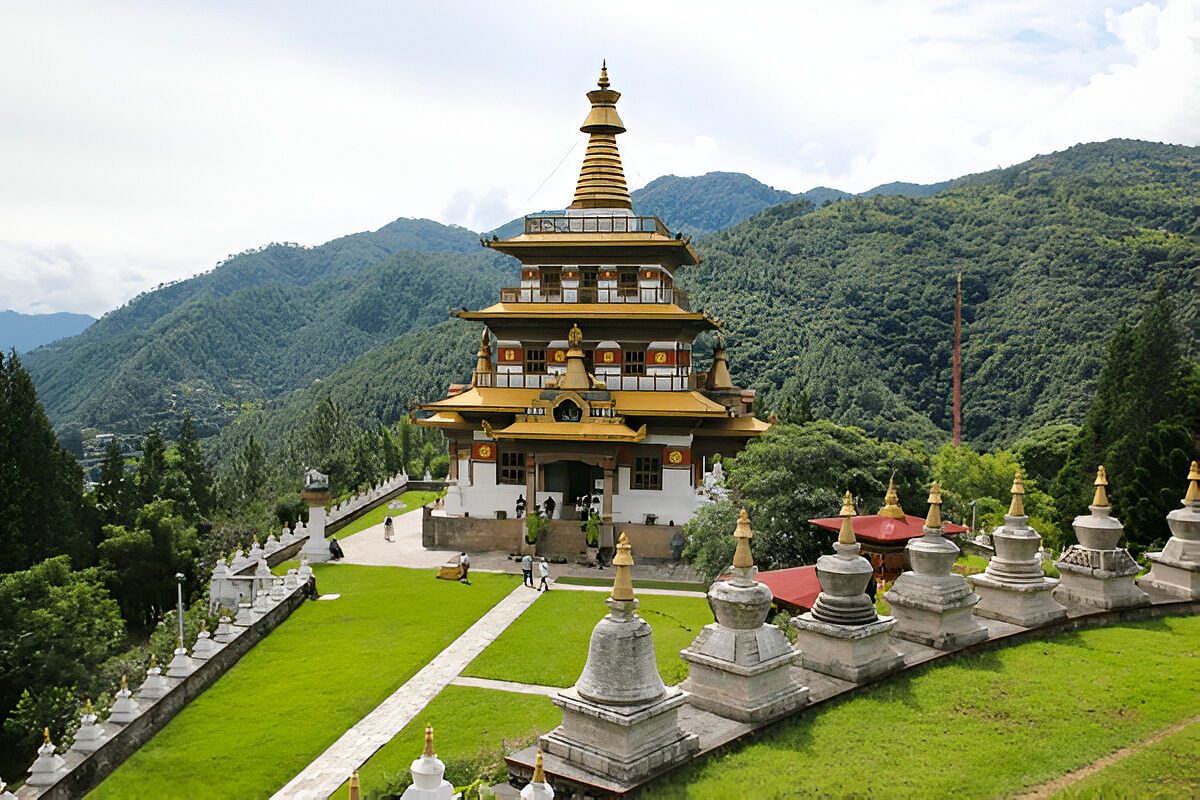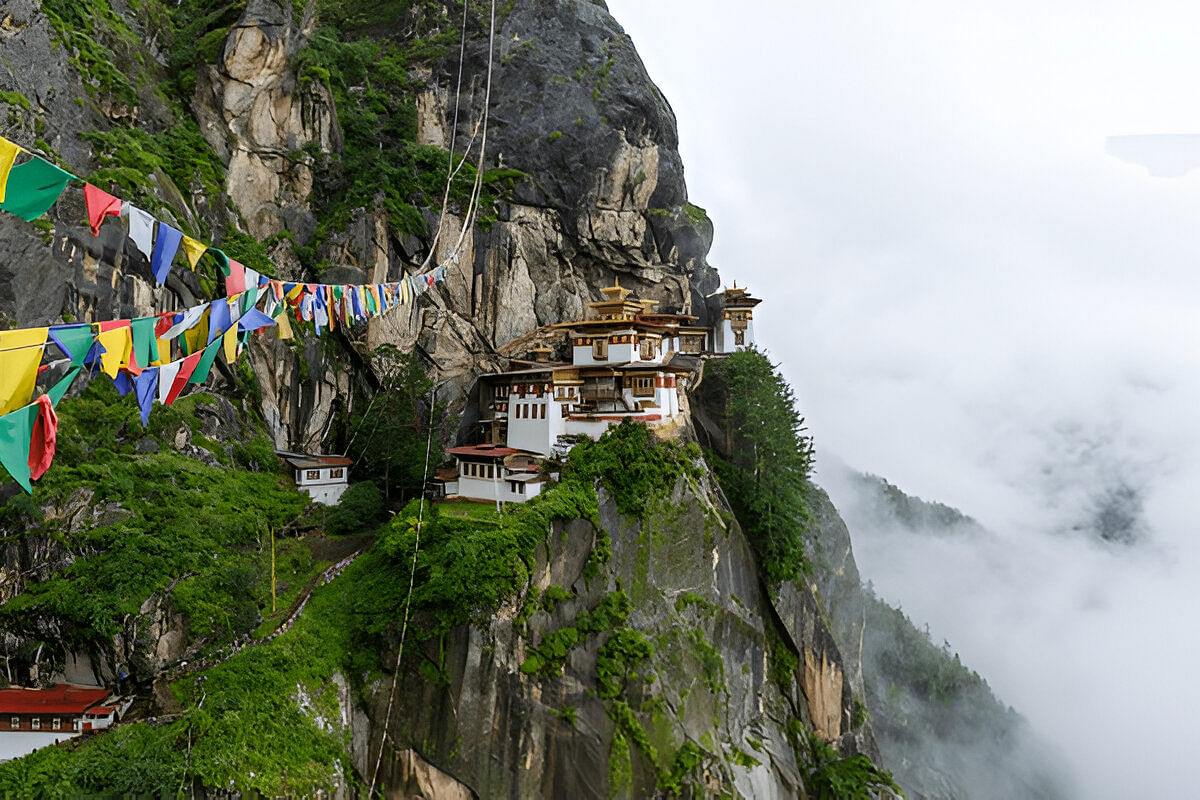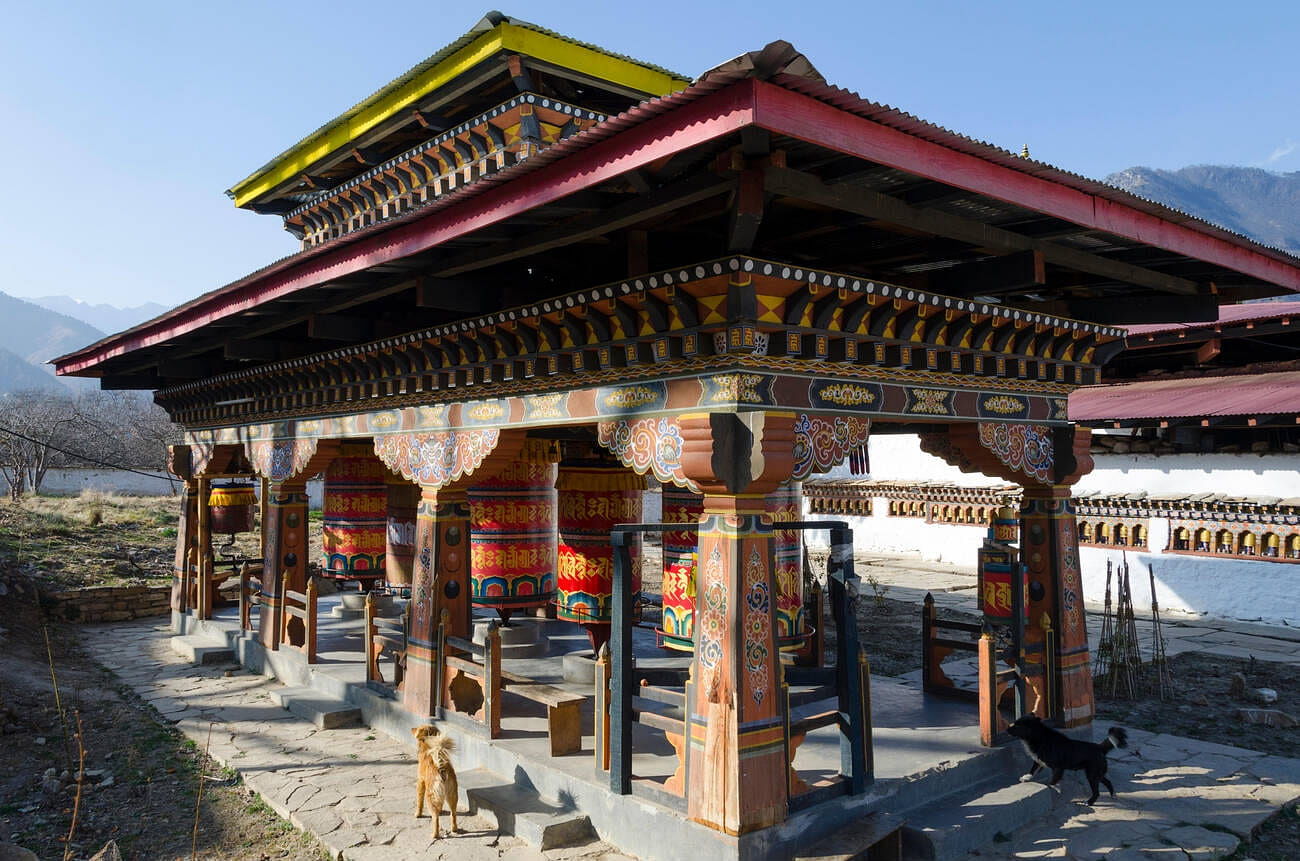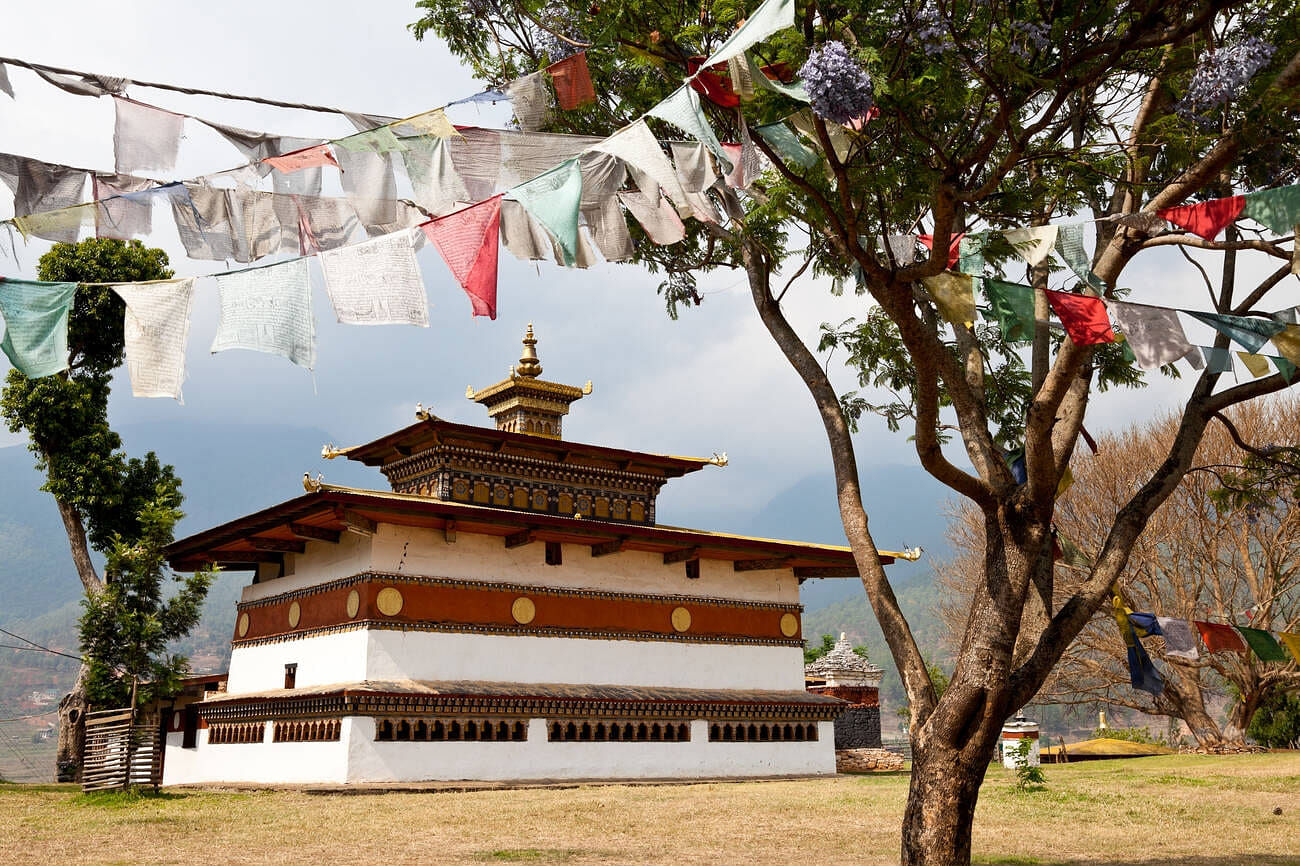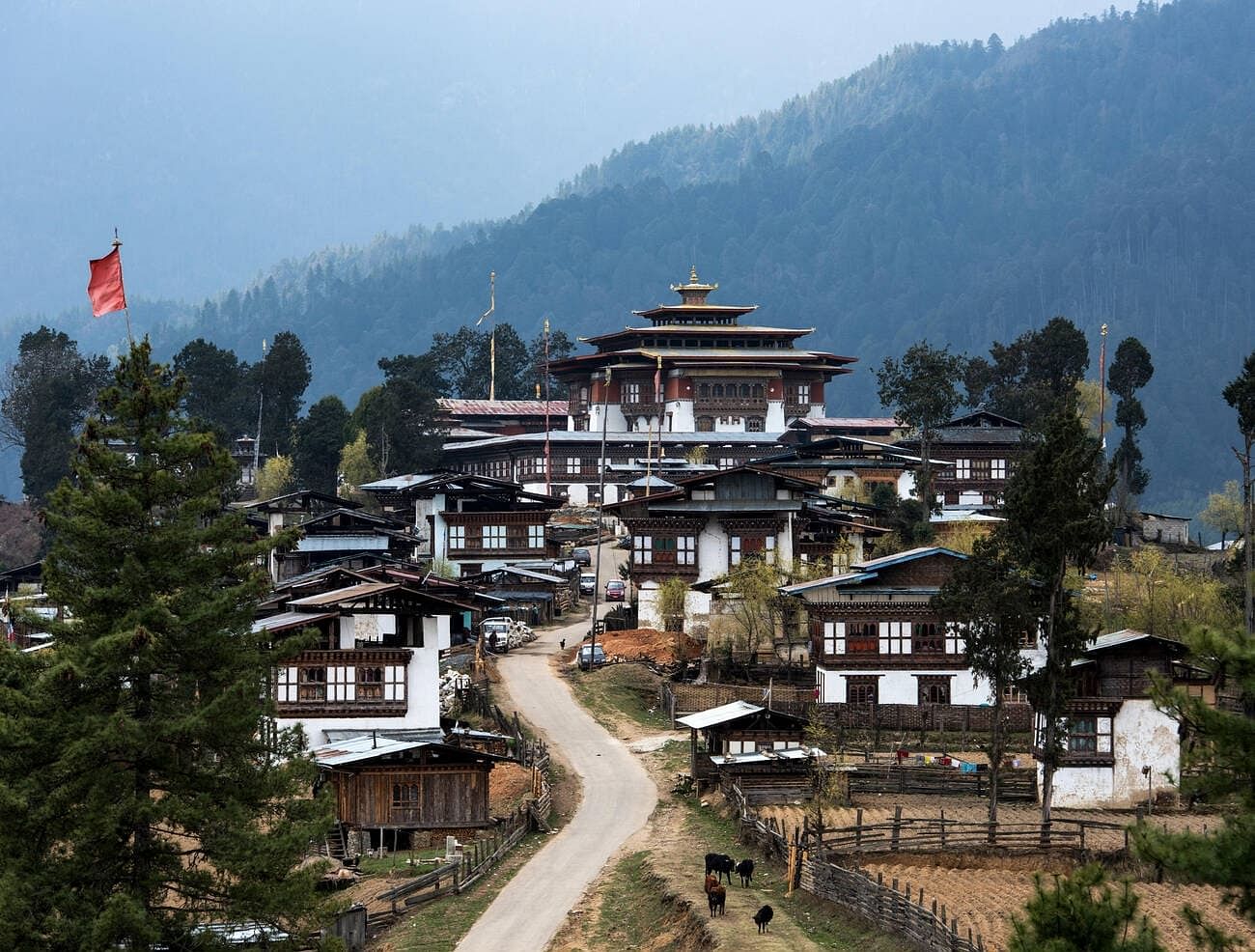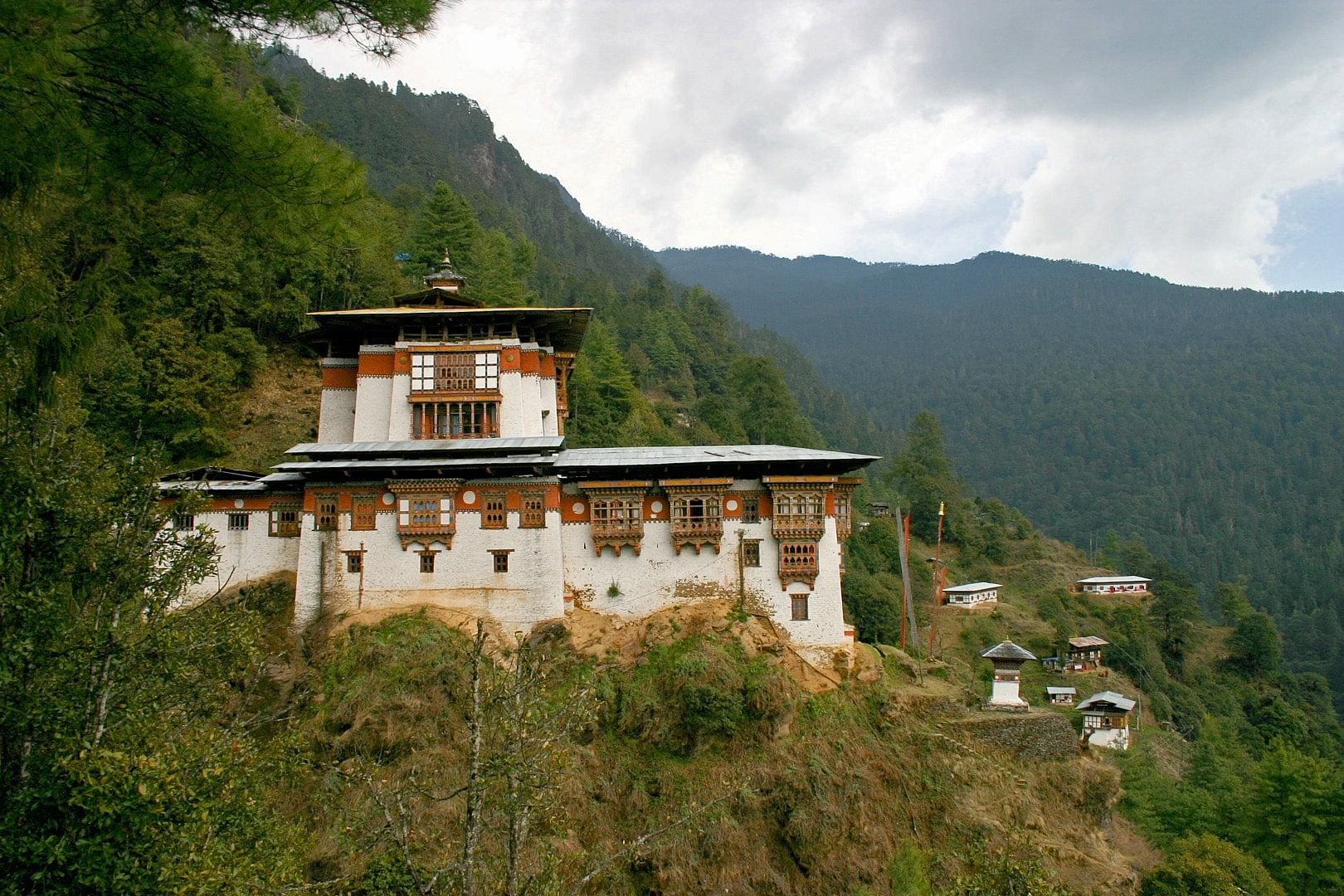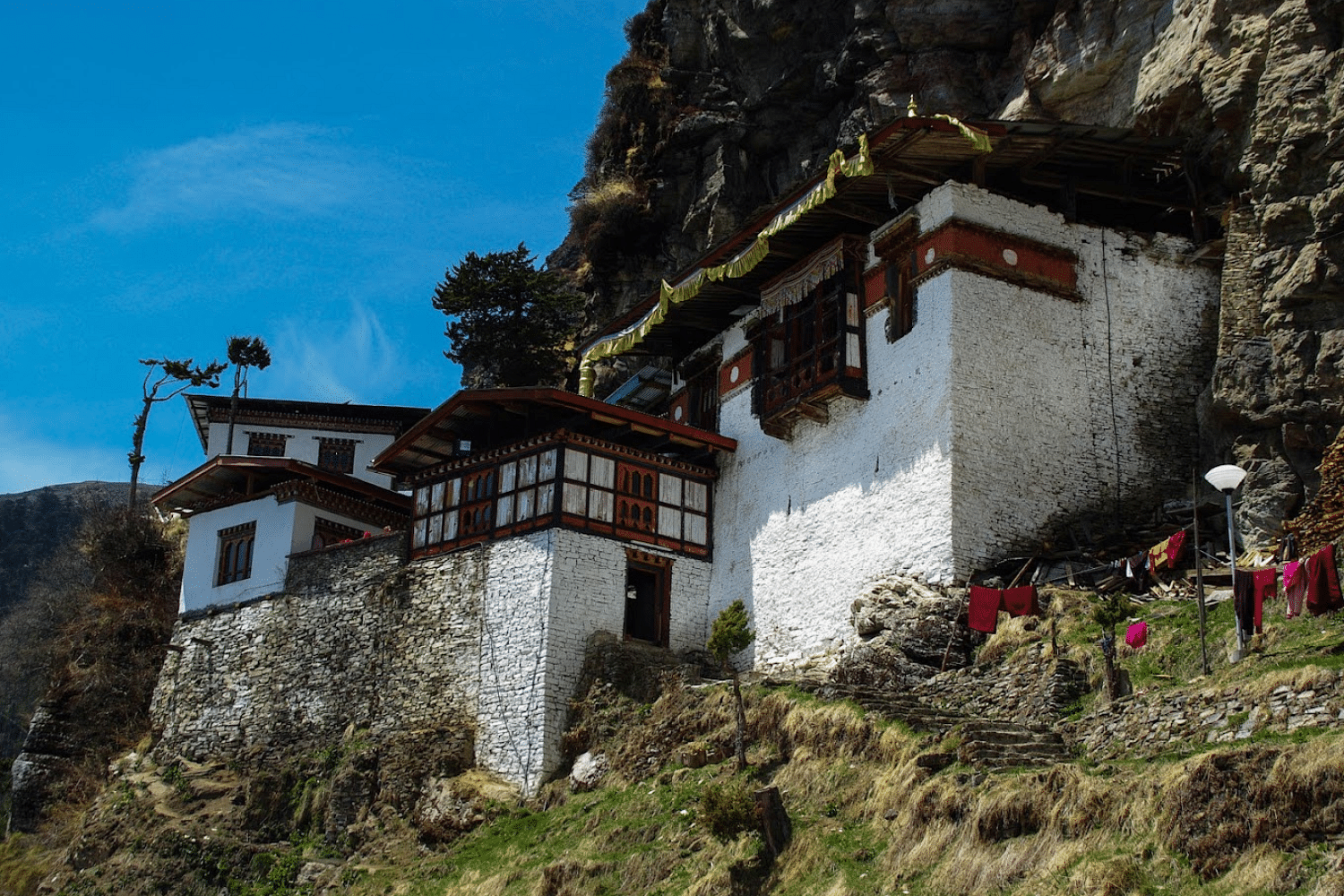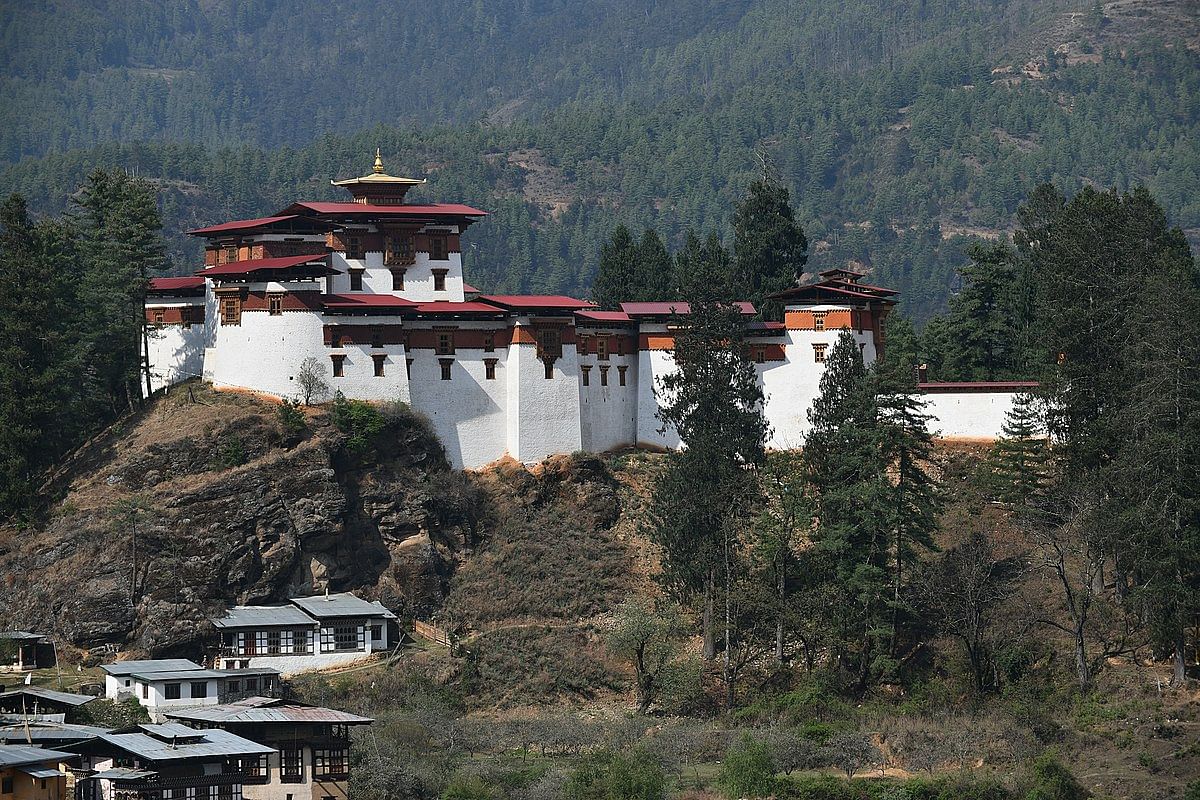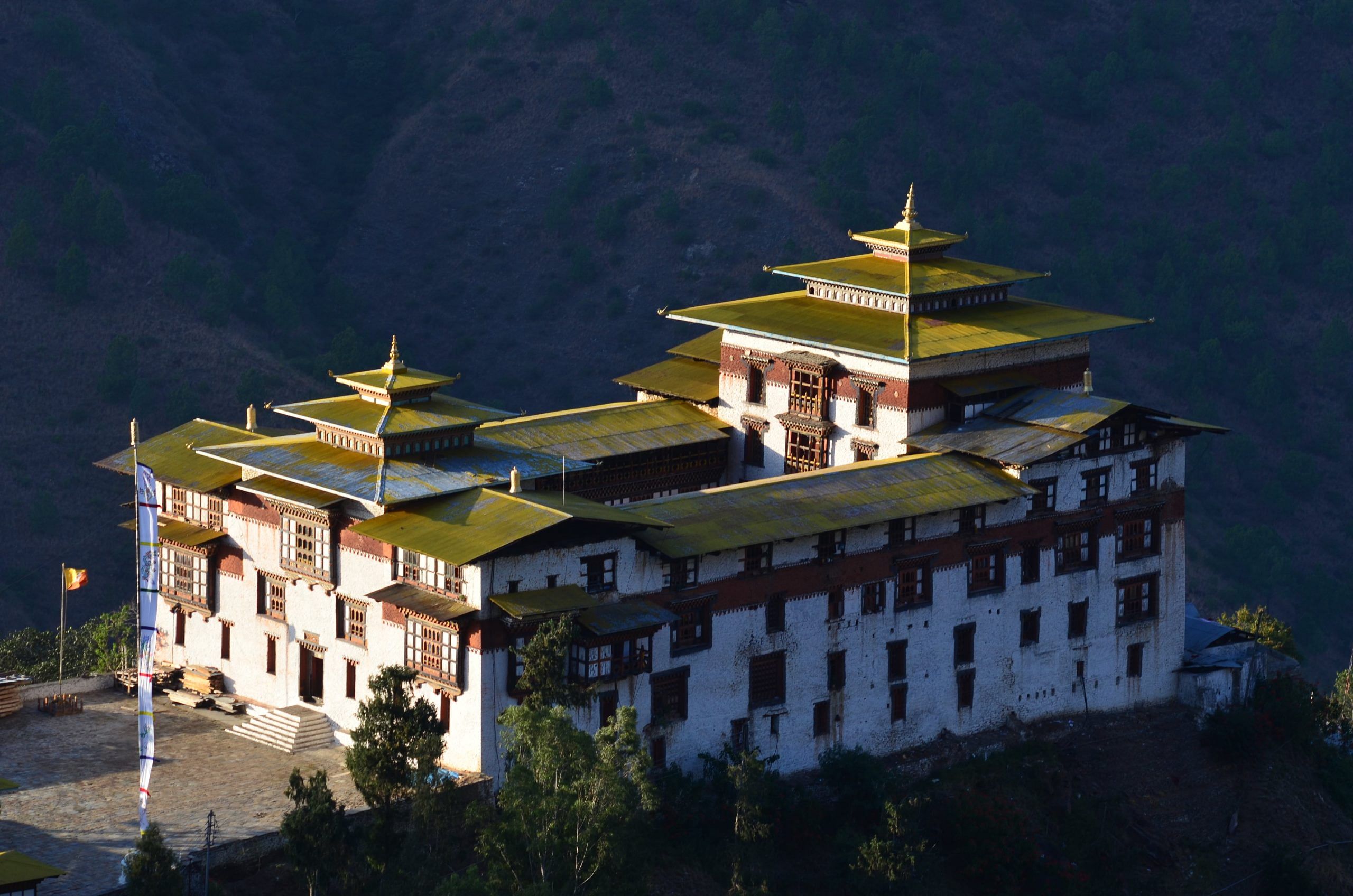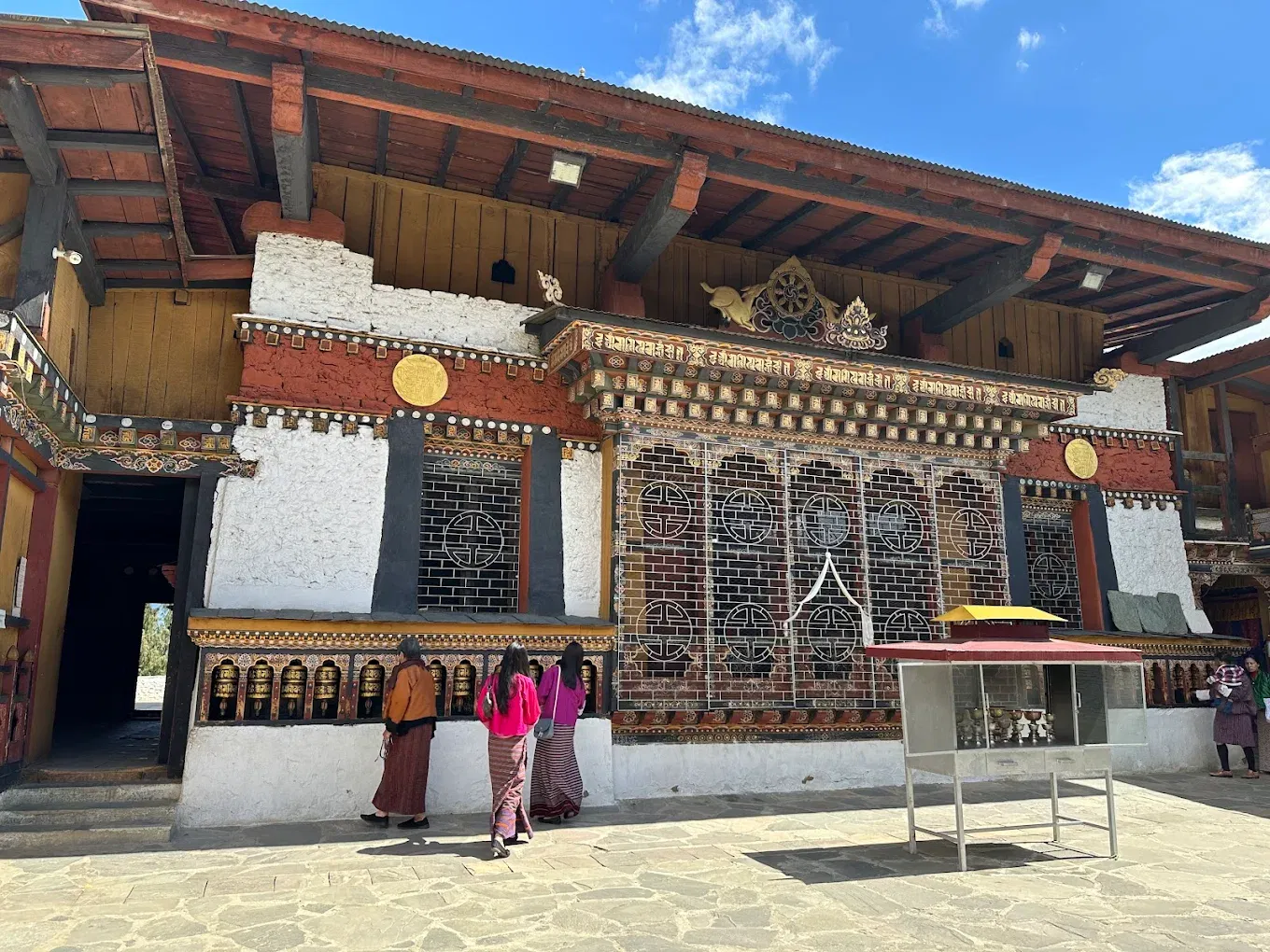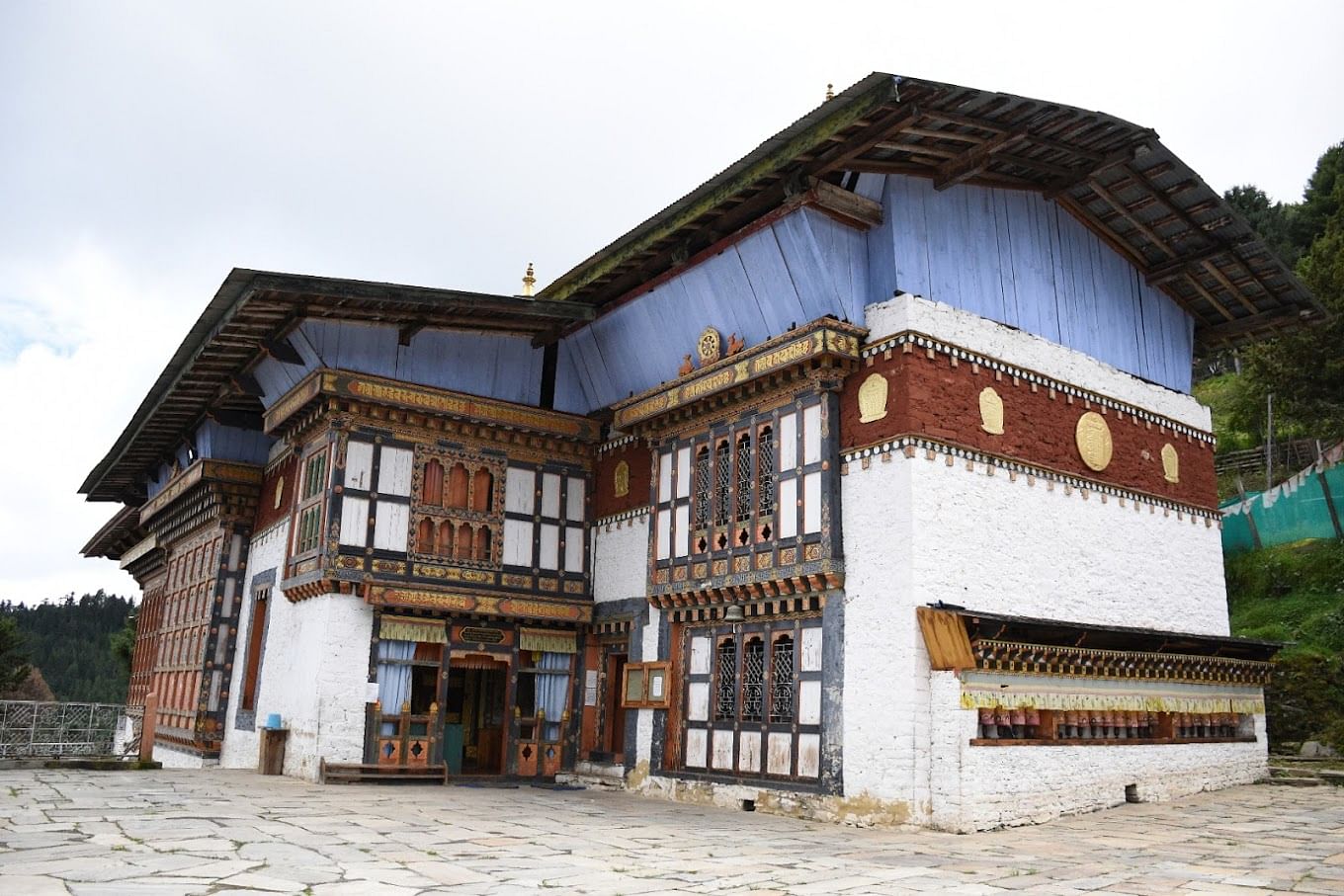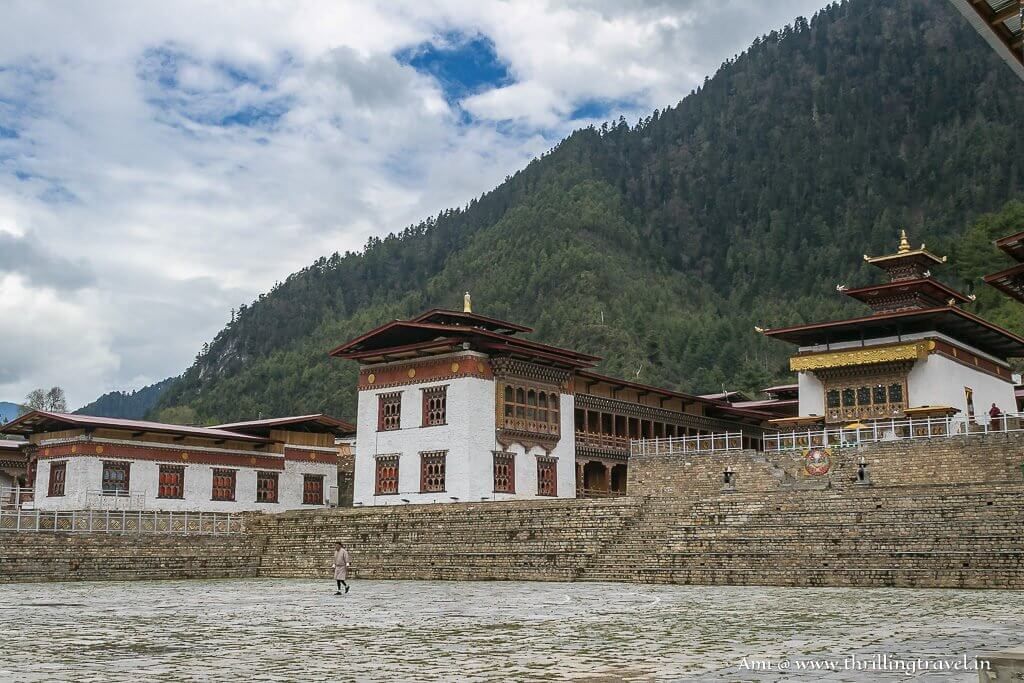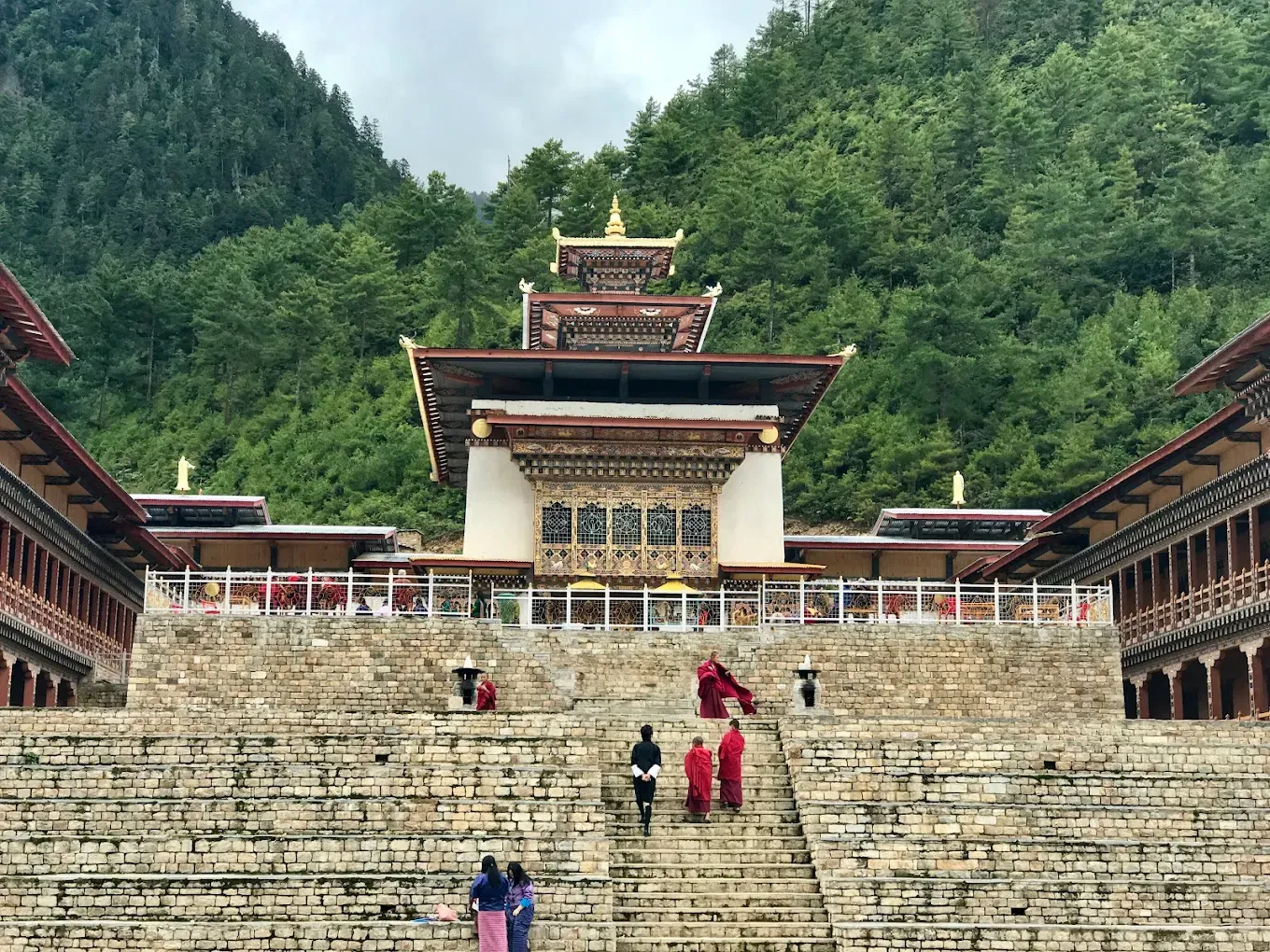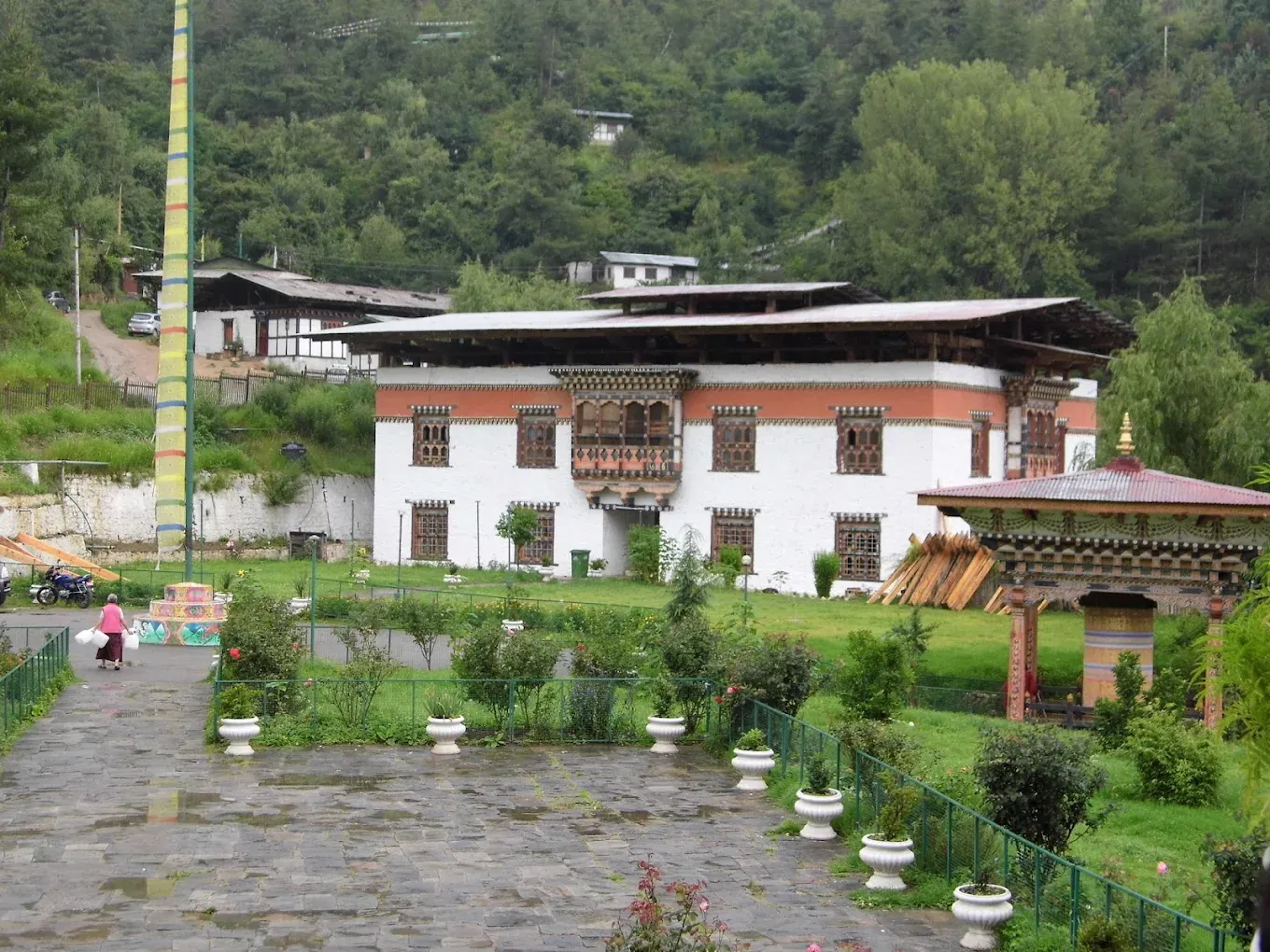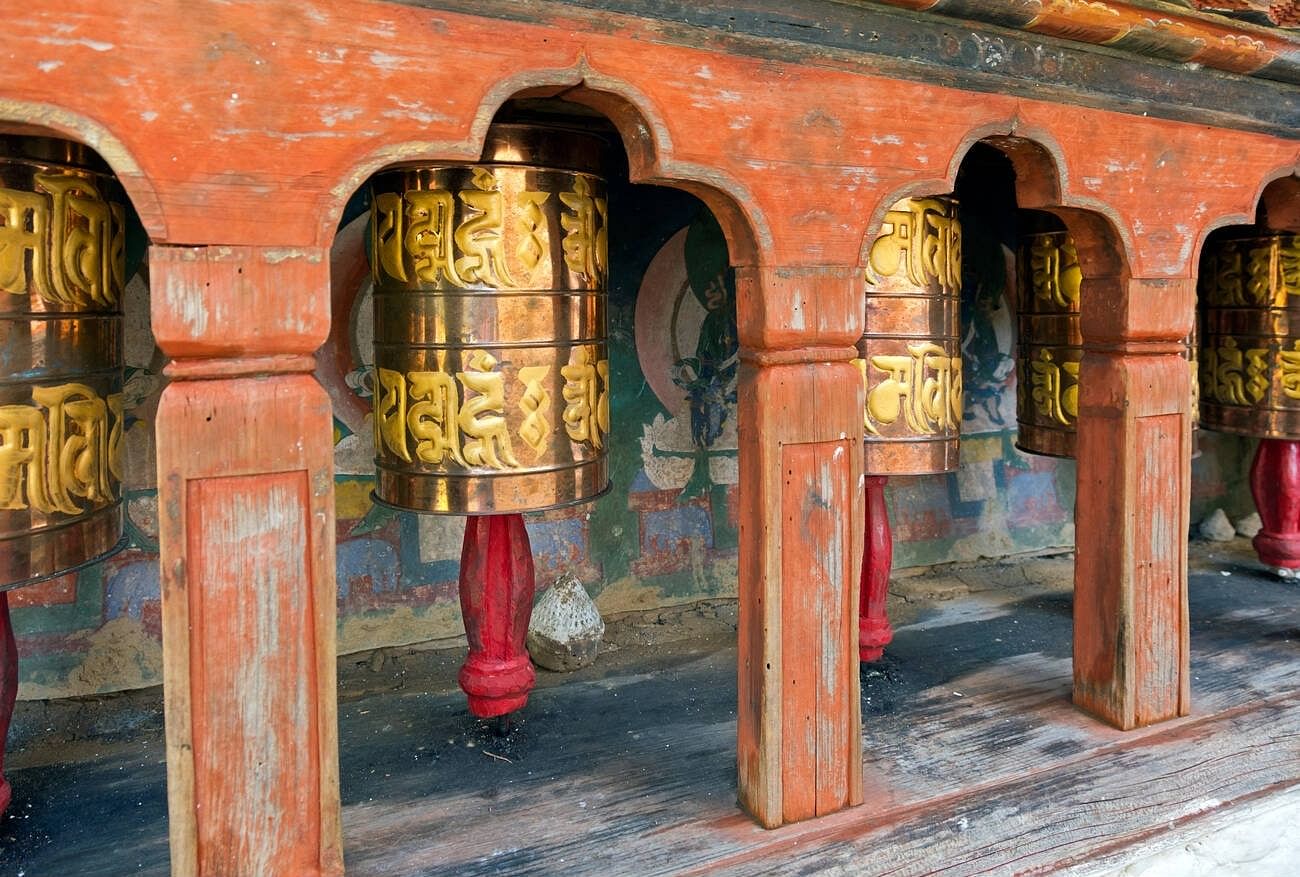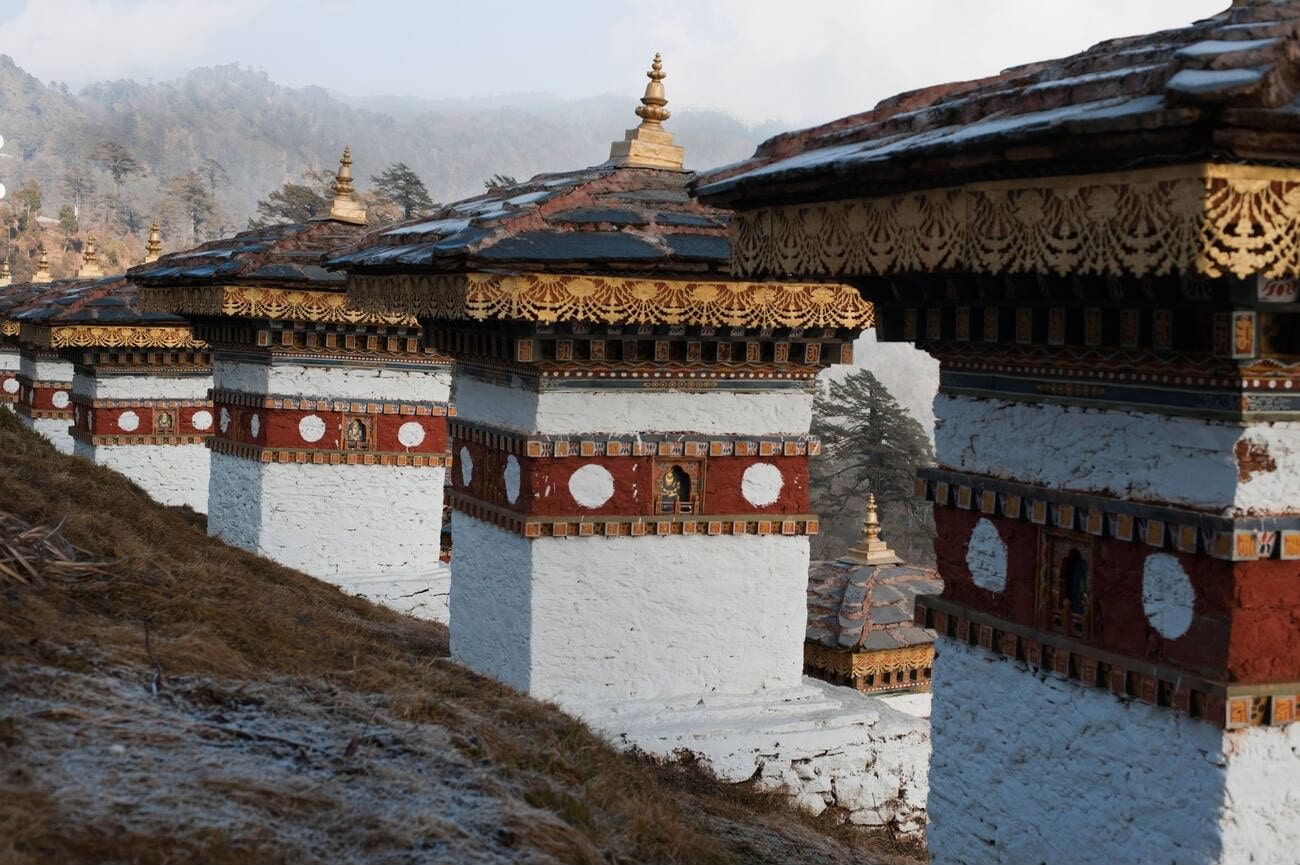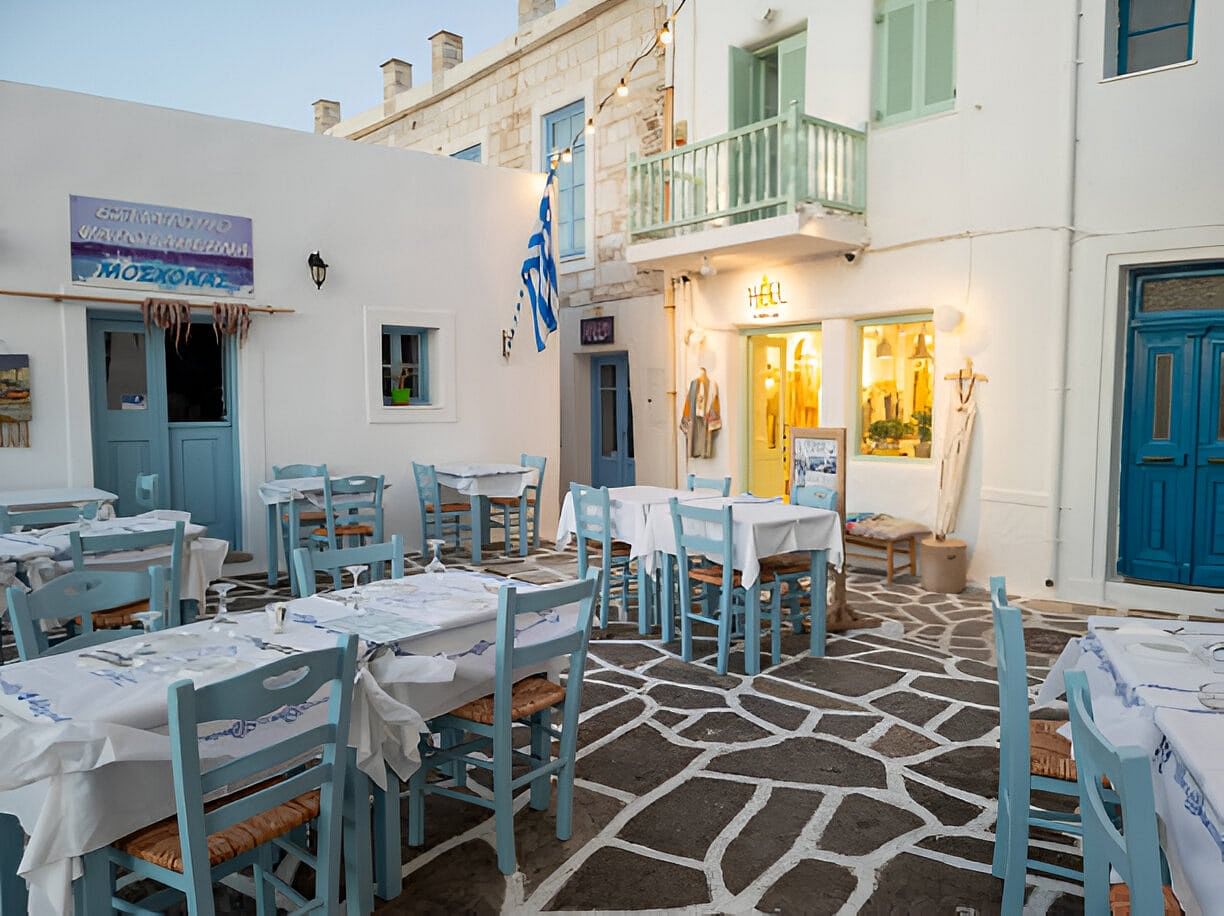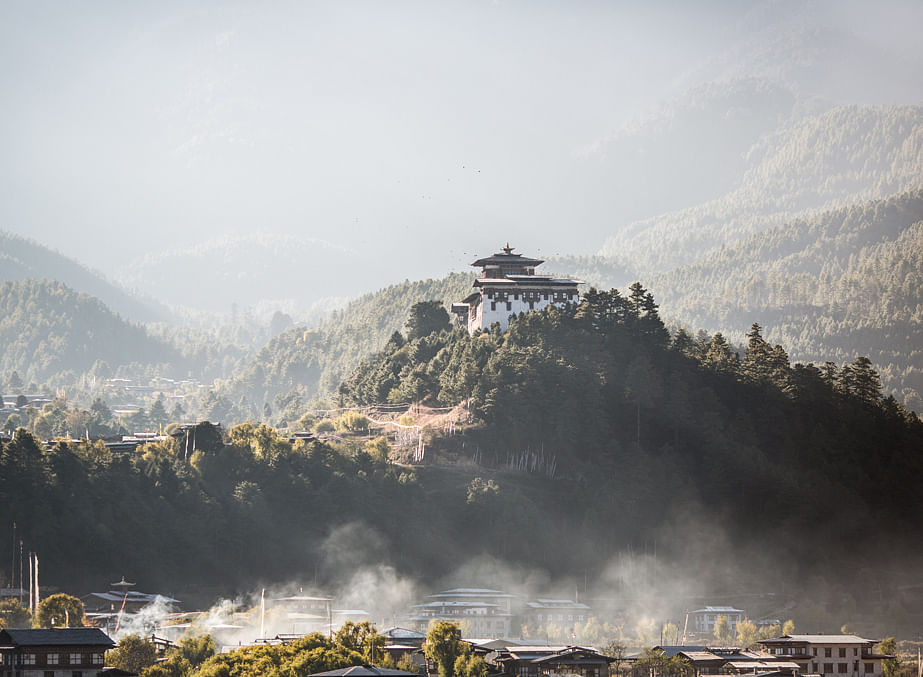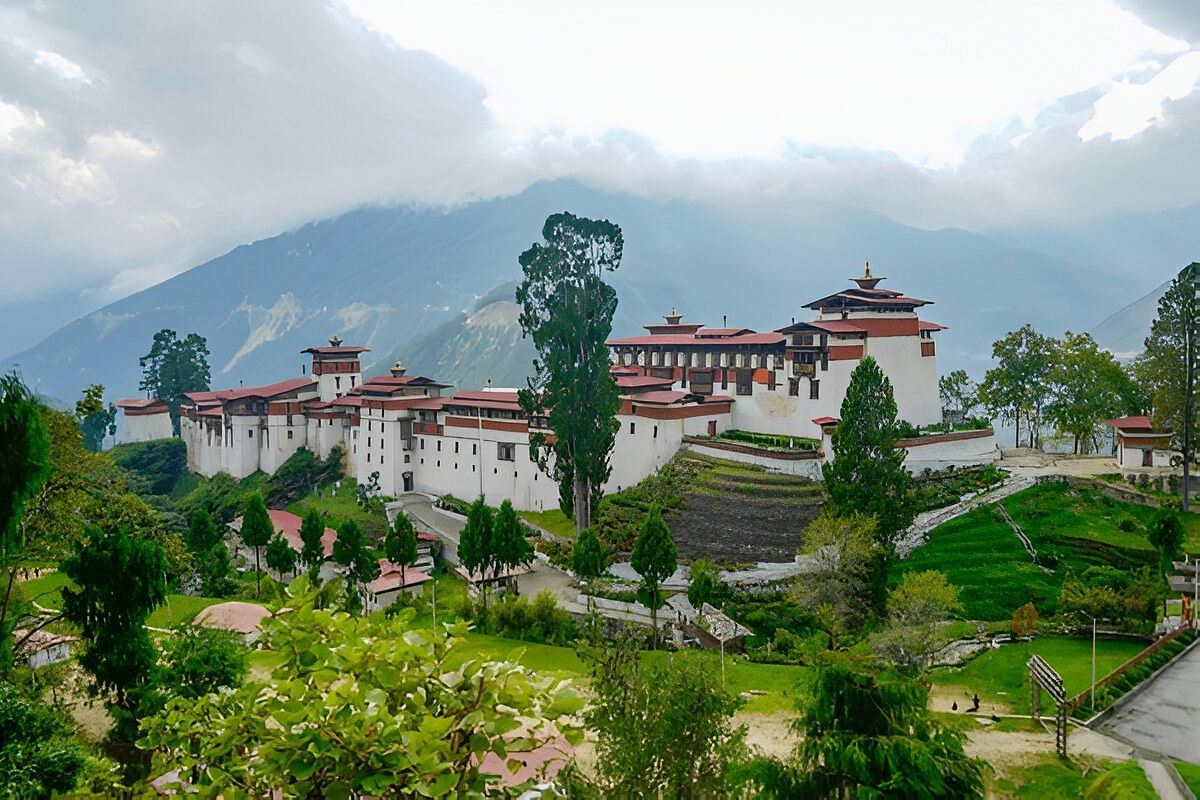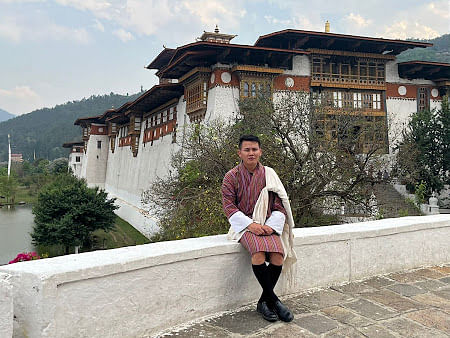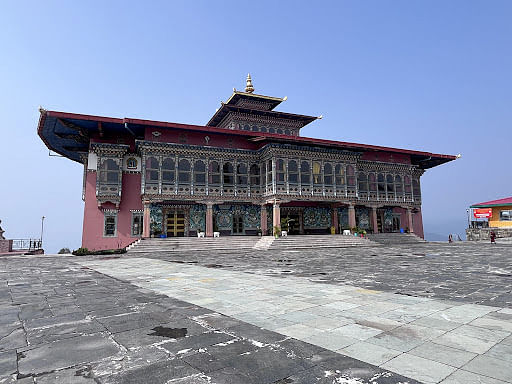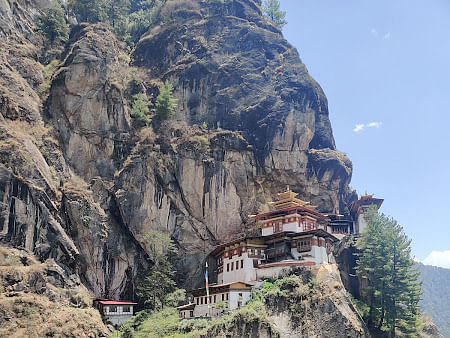You know what hits you in the face when you go to Bhutan? Temples. They're everywhere, and every one of them is like entering another universe.
We're referring to locations such as Tiger's Nest, where a stubborn monk chose to construct a monastery on the face of a cliff. There are also village temples where old grandmothers turn prayer wheels while children frolic outside and large monastery complexes with red-robed monks chanting in the early morning. Each one tells a different tale.
What's wonderful is that these are not museum artefacts. People do use them. You'll see pilgrims walking for days to get there, families making offerings, and monks who've lived this way for centuries. The artwork within will blow your mind—statues and paintings that took years to make, all handmade.
In all honesty, the temples in Bhutan are likely the reason that most people ever fall in love with this nation. They're certainly one of the best places to visit in Bhutan, but they're much more than sightseeing attractions. They're doors into how an entire society perceives life, death, and the rest.
Travel planning? Our Bhutan Tour Packages offer trips to both the popular temples and the secret spots that few tourists ever discover.
Ultimate Guide to 30 Temples in Bhutan
1. Paro Taktsang Monastery (Tiger’s Nest), Paro
Paro Taktsang Monastery, known as Tiger’s Nest, Temples in Bhutan, is a renowned sacred site perched dramatically on a cliffside in Paro, Bhutan. This iconic monastery, built in the 17th century, is considered one of the country’s most sacred and significant pilgrimage destinations.
Legend has it that Guru Rinpoche, the founder of Tibetan Buddhism, meditated in a cave here, riding on the back of a tigress. The monastery consists of several temples and buildings connected by narrow paths and steep stairs. Its stunning location, surrounded by forests and views, makes Tiger’s Nest is one of the Ancient temples in Bhutan and a must-visit attraction for tourists and spiritual seekers.
- Location: Cliffside, Paro Valley, Paro District, Bhutan
- Entry Fees: Nu 2,000 for adults, children under 5 years free, and half-price for ages 6–17.
- Timing: The monastery opens at 8:00 AM. Inner sanctums are open from 8:00 AM to 1:00 PM and again from 2:00 PM to 6:00 PM
2. Punakha Dzong, Punakha
Punakha Dzong, one of the Ancient temples in Bhutan, is an architectural masterpiece and one of the country’s most essential dzongs (fortresses). Built in 1637, it serves as both a religious and administrative centre. Punakha Dzong showcases stunning Bhutanese craftsmanship and design at the confluence of the Pho Chhu (male) and Mo Chhu (female) rivers.
The dzong features intricate woodwork, vibrant murals, and towering white walls adorned with gold and red accents. It also houses sacred relics and is the winter residence of Bhutan’s spiritual leader, Je Khenpo. Punakha Dzong’s pretty setting and cultural significance make it a significant attraction in Bhutan.
- Location: Punakha, Bhutan
- Entry Fees: Around Nu 500 for foreign tourists; locals can visit for free or at a lower charge.
- Timing: In summer, it remains open from 9:00 AM to 5:00 PM. During winter, visiting hours are 11:00 AM to 1:00 PM and again from 3:00 PM to 5:00 PM.
best selling bhutan tour packages
Kyichu Lhakhang is one of the Best temples to visit in Bhutan for tourists, located in Paro. Most of the Temples In Bhutan were built in the 7th century. It is one of the country’s oldest and most sacred temples. Legend has it that the temple was constructed to subdue a giant ogress that was obstructing the spread of Buddhism in the region. Kyichu Lhakhang is adorned with beautiful frescoes, intricate carvings, and statues that depict various Buddhist deities.
It holds immense spiritual significance for the Bhutanese people and is a popular pilgrimage site. Surrounded by peaceful gardens and the majestic Paro Valley, Kyichu Lhakhang offers a peaceful and magical atmosphere for visitors to experience Bhutan’s rich cultural heritage.
- Location: Paro town, Paro District, Bhutan
- Entry Fees: Nu 500 for foreign tourists; children under 5 years free; 6–17 years half fee.
- Timing: The temple is open to visitors from 8:00 AM to 1:00 PM and again from 2:00 PM to 5:00 PM.
4. Chimi Lhakhang (Fertility Temple), Punakha
Chimi Lhakhang, also known as the Fertility Temple, is one of Bhutan’s unique and revered temples. This Bhutan Buddhist temple is dedicated to Drukpa Kunley, a Tibetan Buddhist saint known as the “Divine Madman.” Chimi Lhakhang is famous for its association with fertility and is believed to bless couples with fertility and grant their wishes for children.
Visitors often come to seek blessings and receive phallic-shaped talismans as symbols of fertility. This one of the Top Temples to Visit in Bhutan features colourful murals and ornate decorations, and the countryside offers scenic beauty. Chimi Lhakhang’s reputation as a fertility temple is intertwined with Bhutan’s religious and cultural landscape.
- Location: Teoprongchu, Bhutan
- Entry Fees: Nu 500 for foreign tourists, children 6-17 pay half; under 5 free.
- Timing: 9:00 AM – 5:00 PM
5. Trongsa Dzong, Trongsa
Trongsa Dzong is a majestic fortress and one of the most impressive Temples in Bhutan. Situated in the town of Trongsa, it holds significant historical and strategic significance as the ancestral home of the Bhutanese royal family. Built in the 17th century, Trongsa Dzong stands on a hill overlooking the Mangde Chhu River, commanding views of the surrounding valley.
The Dzong is a massive complex with multiple buildings, courtyards, and temples. It also houses a museum that showcases artefacts and exhibits related to Bhutanese history and culture. Trongsa Dzong is a visual marvel showcasing the Bhutanese Buddhist temple’s rich architectural heritage and is an important administrative and religious centre.
6. Tashichho Dzong, Thimphu
Tashichho Dzong, a famous temple in Bhutan located in Thimphu, is a grand fortress, a Bhutanese Buddhist temple that serves as the seat of the Bhutanese government and is an important religious and administrative centre.
This is one of the most famous temples in Bhutan. Built in the 13th century and extensively renovated in the 20th century, Tashichho Dzong showcases the intricate Bhutanese architectural style with its whitewashed walls, red and gold accents, and sloping roofs.
It houses several government offices, the throne room, and the main temple dedicated to the bodhisattva of compassion, Chenrezig. The dzong’s pretty setting along the Wang Chhu River, surrounded by scenic hills, makes it an iconic landmark and a prominent tourist attraction in Thimphu.
7. Gangtey Monastery, Phobjikha Valley
Gangtey Monastery, situated in the peaceful Phobjikha Valley, is a significant Bhutanese Buddhist Temple, a monastery with cultural and religious importance. Also known as Gangtey Goempa, it was established in the 17th century and belongs to the Nyingma school of Tibetan Buddhism. The monastery is perched on a hilltop, offering views of the beautiful valley below.
Gangtey Monastery is renowned for its unique architectural design and exquisite murals depicting Buddhist teachings and legends. It serves as a spiritual haven for monks and devotees, who come here to study, meditate, and pay homage. The Phobjikha Valley, known for its natural beauty and the presence of endangered black-necked cranes, adds to the tranquillity and charm of Gangtey Monastery.
8. Tango Monastery, Thimphu
Tango Monastery, located in Thimphu, Bhutan Buddhist Temple renowned for its spiritual significance and pretty setting. Founded in the 13th century, it is a prominent centre for higher Buddhist studies. Perched on a hill in dense forests, Tango Monastery offers a peaceful and secluded atmosphere for meditation and contemplation.
The monastery complex consists of several temples, courtyards, and living quarters for the monks. It is also known for the annual Tango Tsechu festival, where colourful masked dances and religious rituals are performed. Tango Monastery is a revered religious institution and a popular destination for trekkers and nature enthusiasts who explore the surrounding trails and enjoy the stunning views of the Thimphu Valley. There are many more places to visit in Bhutan, except for temples.
- Location: Dotanang, Bhutan
- Entry Fees: Free / donations welcome
- Timing: 9:00 AM – 5:00 PM
9. Dochula Pass and Druk Wangyal Chortens, Thimphu
Dochula Pass, located from Thimphu to Punakha in Bhutan, is a scenic mountain pass offering stunning views. It is renowned for the Druk Wangyal Chortens, a collection of 108 memorial stupas built in honour of Bhutanese soldiers who lost their lives in battles.
Each stupa is beautifully adorned with intricate carvings and represents a unique spiritual significance. The pass is a popular tourist attraction with profound cultural and historical importance for the Bhutanese people. Visitors can enjoy the stunning views and soak in the peaceful ambience of the surroundings.
10. Jakar Dzong, Bumthang
Jakar Dzong, also known as the “Castle of the White Bird,” is one of the most impressive temples in Bhutan from the 17th century; it is one of the country’s largest and most essential dzongs. Perched on a ridge overlooking the pretty Chamkhar Valley, Jakar Dzong is an architectural marvel with towering white walls, elegant courtyards, and intricate woodwork.
The dzong is an administrative centre housing government offices and monastic quarters. It also hosts various religious festivals, including the popular Jakar Tshechu. Jakar Dzong is one of the popular temples in Bhutan. It is a significant cultural landmark and offers stunning views and a sense of tranquillity to its visitors.
11. Wangdue Phodrang Dzong, Wangdue Phodrang
Wangdue Phodrang Dzong, located in the Wangdue Phodrang district of Bhutan, is a historic fortress on a ridge overlooking the convergence of the Punatsangchhu and Dangchhu rivers. This famous temple in Bhutan in the 17th century was a strategic stronghold in the region.
Sadly, the dzong was partially destroyed by a fire in 2012, but reconstruction efforts are underway to restore its former glory. Wangdue Phodrang Dzong showcases traditional Bhutanese architecture with towering walls, intricate woodwork, and ornate decorations.
The dzong has served as an administrative centre and a venue for religious ceremonies and festivals. Its scenic location and cultural significance make it an intriguing destination for visitors exploring the beauty of Bhutan.
Kila Gompa, also known as the Chele La Gompa, is a sacred Bhutanese Buddhist Temple in the Paro district of Bhutan. Perched at 3,500 metres (11,480 feet) on the slopes of the Chele La Pass, this famous temple in Bhutan offers stunning views of the surrounding mountains and valleys in Bhutan. The monastery is renowned for its meditation retreats and is home to a small community of nuns.
Kila Gompa is known for its peaceful ambience, making it an ideal place for contemplation and spiritual practice. People can hike or drive to the monastery and experience this hidden gem’s serenity and natural beauty in Bhutan.
- Location: Paro, Bhutan
- Entry Fees: Free / donations welcome
- Timing: 8:00 AM – 4:00 PM
13. Nalanda Monastery, Punakha
Nalanda Monastery, one of the Top Temples to visit in Bhutan, Punakha, is a prominent Buddhist educational institution and a centre for spiritual learning. Established in 2011, it follows the tradition of Nalanda, an ancient Buddhist education centre in India. The monastery offers a comprehensive curriculum of Buddhist philosophy, meditation, and other sacred arts.
Nalanda Monastery provides a peaceful and peaceful environment for monks and students to engage in their studies and spiritual practices. The monastery complex features a main temple, residential quarters, classrooms, and meditation halls. It serves as a hub for preserving and promoting Bhutanese Buddhist heritage while nurturing the growth of future Buddhist scholars and practitioners.
14. Lhuentse Dzong, Lhuentse
Lhuentse Dzong, the famous temple in Bhutan, is a historic fortress that stands proudly on a hilltop overlooking the pretty Kurichu River. It’s one of the temples in Bhutan, a remote and least visited dzong.
Lhuentse Dzong is renowned for its architectural beauty, featuring intricate woodwork, vibrant paintings, and ornate decorations. The dzong is an administrative Bhutanese Buddhist temple with government offices and monastic quarters.
It is also known for the annual three-day Lhuentse Tshechu festival, where locals and visitors come together to witness traditional mask dances, cultural performances, and religious rituals. Lhuentse Dzong offers a glimpse into the rich cultural heritage of Bhutan and the tranquillity of its natural surroundings.
Rinpung Dzong, one of the popular temples in Bhutan, is an iconic fortress that is a prominent symbol of Bhutanese architecture and history. It is a monastic and administrative centre. Rinpung Dzong features intricate woodwork, beautifully painted murals, and ornate decorations, showcasing the craftsmanship of Bhutanese artisans.
The dzong is also famous for hosting the annual Paro Tshechu, a vibrant festival where locals and visitors come together to witness masked dances, cultural performances, and religious rituals. Its strategic location overlooking the Paro Valley and Rinpung Dzong temples in Bhutan offers stunning views and a peaceful atmosphere.
Drukgyel Dzong, one of the temples in Bhutan, has a historic fortress and significant cultural importance. The dzong served as a defence fortress against invasions from Tibet. The imposing ruins of Drukgyel Dzong, set against the backdrop of the towering Mount Jomolhari, are a captivating sight for visitors.
Drukgyel temples in Bhutan, despite being partially destroyed by a fire in 1951, the remaining walls and towers still reflect their heyday’s grandeur and architectural brilliance.
Drukgyel Dzong is not only a visual marvel but also holds a symbolic value as a testament to Bhutanese resilience and rich heritage. It is a popular destination for tourists exploring Bhutan’s historical and cultural treasures.
17. Trashigang Dzong, Trashigang
Trashigang Dzong, one of the most visited temples in Bhutan, stands proudly on a hilltop overlooking the Gamri River. Trashigang Dzong showcases traditional Bhutanese architecture with whitewashed walls, red and gold accents, and towering watchtowers.
The dzong serves as the administrative and judicial centre of the Trashigang district, making it one of the most visited temples in Bhutan. It also hosts various religious ceremonies and festivals, including the popular Trashigang Tshechu.
The dzong’s strategic location and stunning views of the surrounding landscapes make it a remarkable landmark and a notable attraction for visitors exploring eastern Bhutan. Bhutan Buddhist temples are famous for their serenity along peace.
18. Changangkha Lhakhang, Thimphu
Changangkha Lhakhang, one of the most renowned temples in Bhutan, is a sacred Buddhist temple in Thimphu, Bhutan’s capital city. It was established in 1974 by the third king of Bhutan, Jigme Dorji Wangchuck, and serves as the monastery of the Central Monastic Body.
The Changangkha Lhakhang is dedicated to the protective deity Dorje Setrab and is considered a place of great spiritual significance. The monastery houses a central statue of Buddha, along with various religious artefacts and scriptures. It is open to both monks and the public, offering a peaceful and peaceful space for prayer and meditation.
19. Lhodrak Nyidey Monastery, Thimphu
Lhodrak Nyidey Monastery, a temple in Bhutan, Thimphu district of Bhutan, is a revered Buddhist Temple known for its spiritual teachings and cultural significance.
Founded in the 1980s by the renowned Nyingma master, Jigme Phuntsok Rinpoche, the sanctuary is a vibrant centre of Buddhist learning and practice. Lhodrak Nyidey Monastery features traditional Bhutanese architecture with white walls, colourful woodwork, and ornate decorations.
It houses a large assembly hall where monks gather for prayers and religious ceremonies.
Surrounded by peaceful natural beauty, Lhodrak Nyidey Monastery is one of Bhutan’s Popular temples, offering a quiet and contemplative atmosphere for spiritual seekers and cultural enthusiasts.
20. Gangzur Village Monastery, Lhuntse
Gangzur Village Monastery is a hidden gem in Bhutan’s scenic Lhuntse district. This peaceful monastery exudes a tranquil atmosphere and offers stunning views of the surrounding mountains and valleys. Its traditional Bhutanese architecture and vibrant Buddhist artwork glimpse the region’s rich cultural heritage.
The monastery serves as a spiritual retreat and centre for Buddhist studies, attracting both locals and curious travellers seeking solace and enlightenment. Its secluded location adds to the charm, immersing visitors in a peaceful and meditative ambience while exploring the spiritual teachings and rituals practised within its sacred walls. You can also hog on to delicious Bhutanese food while visiting these temples.
21. Tharpaling Monastery, Bumthang
Tharpaling Monastery is one of the revered Buddhist sites in Bhutan’s pretty Bumthang district. Perched atop a hill, this ancient monastery offers a captivating blend of natural beauty and spiritual serenity.
The monastery holds significant religious importance and is renowned for its historical and cultural value. With its intricate murals, ornate statues, and peaceful prayer halls, Tharpaling provides a sacred space for meditation, reflection, and Buddhist teachings.
Visitors can embark on a scenic hike to reach the monastery, immersing themselves in the tranquil ambience while enjoying views of the surrounding valleys. Tharpaling Monastery is a cherished destination for spiritual seekers and nature enthusiasts.
22. Lhakhang Karpo (White Temple)
Lhakhang Karpo, meaning the White Temple, is one of Bhutan’s oldest temples and a significant spiritual site in the Haa Valley. Built in the 7th century by King Songtsen Gampo, it was established after a white pigeon, believed to be a deity, marked the sacred spot.
This beautiful structure represents purity and peace among all Bhutan temples. The temple’s whitewashed walls, traditional Bhutanese architecture, and detailed carvings attract both pilgrims and travellers. Surrounded by scenic mountains, Lhakhang Karpo stands as a symbol of faith and harmony, paired with the nearby Lhakhang Nagpo (Black Temple).
- Location: Bondey-Haa Hwy, Bhutan
- Entry Fees: Free
- Timing: 9:00 AM – 5:00 PM, lunch break from 1:00 PM to 2:00 PM
23. Lhakhang Nagpo, Haa Valley
Lhakhang Nagpo, also known as the Black Temple, is one of Bhutan’s oldest temples, located in the serene Haa Valley. Built in the 7th century by King Songtsen Gampo, it holds great spiritual and historical value among Bhutan temples.
According to legend, a black pigeon guided the King to this sacred site where the temple was built to honour the protective deity Mahakala. The temple’s dark interior, ancient murals, and peaceful surroundings reflect Bhutan’s deep Buddhist heritage. Along with its nearby counterpart, Lhakhang Karpo (White Temple), it represents the strong spiritual balance found in Bhutanese culture.
- Location: Takchu, Bhutan
- Entry Fees: Free
- Timing: 8:00 AM – 5:00 PM, lunch break from 1:00 PM to 2:00 PM
24. Kurjey Lhakhang, Bumthang
Kurjey Lhakhang is a sacred temple complex in Bumthang, built around a cave where Guru Rinpoche meditated centuries ago. The site consists of three temples, each holding religious importance and relics. Pilgrims visit to offer prayers, light butter lamps, and seek blessings. The surroundings are peaceful, with greenery and flowing streams, making it a perfect place for meditation.
Kurjey Lhakhang is not just a temple; it is a window into Bhutan’s spiritual history. Visitors can witness traditional Bhutanese rituals and experience the deep cultural heritage of the country in a serene and calm atmosphere.
25. Tamshing Lhakhang, Bumthang
Tamshing Lhakhang, built in the 15th century, is one of the most important temples in Bumthang. It is known for its beautiful murals and artwork that depict the teachings of Buddhism. The temple belongs to the Nyingma school and has preserved ancient manuscripts for centuries.
Visitors come here to admire the art, meditate, and experience Bhutanese spiritual traditions. Tamshing Lhakhang hosts festivals and rituals that give travellers a glimpse of local culture. The calm environment, combined with its historical and religious significance, makes it a must-visit for anyone exploring Bhutan’s rich spiritual heritage and cultural beauty.
26. Jambay Lhakhang, Bumthang
Jambay Lhakhang is one of the oldest temples in Bhutan, built in the 7th century by King Songtsen Gampo. It is famous for the Jambay Lhakhang Drup, a fire festival held every year that attracts devotees and tourists alike. The temple has beautiful carvings, ancient statues, and traditional Bhutanese architecture.
Pilgrims visit to pray and make offerings, while visitors admire its historical importance and peaceful surroundings. Located in the scenic Bumthang Valley, Jambay Lhakhang is a perfect blend of culture, religion, and nature. It gives visitors a deep understanding of Bhutan’s Buddhist traditions and ancient architectural style.
27. Chagri Monastery (Chagri Dorjee Monastery), Thimphu Valley
Chagri Monastery, located on a hill in Thimphu Valley, is historically important as the first meditation centre established by Zhabdrung Ngawang Namgyal. It served as a training centre for monks and a place for meditation and spiritual learning. The monastery is surrounded by forests and offers stunning views of the valley below.
Visitors can hike to reach the monastery, enjoying the peaceful atmosphere along the way. Inside, the traditional Bhutanese architecture, statues, and prayer halls provide a glimpse into monastic life. Chagri Monastery remains a quiet and spiritual place for reflection, prayer, and understanding Bhutanese Buddhist practices.
28. Simtokha Dzong, Thimphu
Simtokha Dzong, built in 1629, is the first dzong of Bhutan and a symbol of the country’s history. It served as both a fortress and a monastery. The dzong is small compared to others but is famous for its intricate murals, wooden carvings, and religious significance. Visitors can explore the temples, prayer halls, and fort-like architecture while learning about Bhutanese history.
The dzong is surrounded by peaceful hills and scenic landscapes, making it a calm and inspiring place. Simtokha Dzong offers a perfect blend of religion, culture, and history, giving visitors insight into Bhutan’s traditional way of life.
29. Phajoding Monastery, Thimphu
Phajoding Monastery is located on a ridge above Thimphu, providing panoramic views of the valley and surrounding mountains. It is a serene place for meditation and spiritual learning, where monks study and practice Buddhist teachings.
The monastery consists of prayer halls, stupas, and living quarters for monks. Visitors often trek to reach Phajoding, enjoying the quiet paths and natural beauty along the way. The calm environment makes it ideal for reflection and connecting with Bhutanese spiritual traditions. Phajoding Monastery is a hidden gem for travellers seeking peace, stunning views, and a deep experience of Bhutanese Buddhism.
30. Pemagatshel Dzong, Pemagatshel
Pemagatshel Dzong is a peaceful and beautiful temple in Bhutan, located on a hill in the Pemagatshel district. It is both a religious and a government centre for the area. The dzong looks over green valleys and small villages, giving amazing views.
Like many ancient temples in Bhutan, it has beautiful Bhutanese designs, wooden carvings, and holy statues inside. Local people visit it for prayers, festivals, and special events. The quiet atmosphere and spiritual energy make Pemagatshel Dzong a lovely place to learn about Bhutan’s culture and Buddhist way of life.
trending bhutan trip package
Best time to visit Bhutan for temple tours
The Best time to visit Bhutan for temple tours is during the spring (March to May) and autumn (September to November) due to pleasant weather and fewer crowds. These seasons provide comfortable temperatures and clear skies, making exploration enjoyable.
Additionally, many vibrant festivals, like Paro Tsechu and Thimphu Tsechu, take place during these months, enhancing your cultural experience.
History of Bhutan Temples
Bhutan, a small Himalayan country, is known for its rich Buddhist culture and beautiful temples. The Historical temples in Bhutan have a long connection to the country’s religious and political growth.
Early Buddhist Influence:
- Ashoka’s Mission: The history of Bhutan temples dates back to the reign of Indian Emperor Ashoka (3rd century BCE), who sent Buddhist missionaries to the region, spreading the faith.
- Tibetan Influence: Bhutan’s Buddhist traditions were shaped by Tibetan Buddhism, bringing in various sects and practices.
Rise of Dzong Culture:
- Dzongs: These are large fortress-like buildings that served both as temples and defensive structures, central to Bhutan’s religious life.
Gelugpa Sect: The Gelugpa sect of Tibetan Buddhism became dominant in Bhutan, leading to the construction of many dzongs and monasteries in Bhutan.
Places to Stay around Temples in Bhutan
Here are some recommended places to stay around temples in Bhutan:
1. Paro:
- Zhiwa Ling Heritage: Combines traditional architecture with modern comfort near Paro Taktsang.
- Uma Paro: Luxurious hotel with stunning valley views and close to Kyichu Lhakhang.
- Taj Tashi: Elegant hotel near Rinpung Dzong.
2. Punakha:
- Drubchhu Resort: Cosy resort with views near Punakha Dzong and Chimi Lhakhang.
- Hotel Lobesa: Comfortable hotel providing easy access to local temples.
- Punakha River Lodge: Riverside lodging perfect for relaxation.
3. Thimphu:
- Taj Tashi: Luxurious hotel featuring traditional architecture near Tashichho Dzong.
- Khangkhu Resort: A Peaceful resort near Tango Monastery.
- Hotel Bhutan: Budget-friendly option with access to local attractions.
4. Bumthang:
- Yangkhil Resort: Peaceful resort near Jakar Dzong, ideal for temple exploration.
- Jakar Village Lodge: Cosy lodge offering easy access to Tharpaling Monastery.
5. Gangtey Valley:
- Gangtey Lodge: A Luxurious lodge near Gangtey Monastery.
- Gangtey Goenpa Lodge: Quaint lodge providing a unique cultural experience, and is one of the finest places to stay around temples in Bhutan.
These are just a few examples of the places to stay around temples in Bhutan.
Places to Eat near Temple in Bhutan
Here are some places to eat near a temple in Bhutan:
1. Paro:
- Druk Choe Restaurant: Near Paro Taktsang Monastery, offering Bhutanese and international dishes.
- Bhutan Kitchen: Traditional Bhutanese cuisine located near Paro International Airport.
2. Punakha:
- Punakha River Lodge Restaurant: Offers views of the Punakha River with a variety of dishes.
- Druk Wangyal Restaurant: Near Punakha Dzong, serving Bhutanese and international options.
- Punakha Cafeteria: A simple spot for basic meals at affordable prices.
3. Thimphu:
- Bhutan Kitchen: Traditional Bhutanese cuisine near the National Library of Bhutan.
- Zoel Cafe: Popular for coffee and snacks near Tashichho Dzong.
- Bhutan Traditional Restaurant: Located near Thimphu Chorten, serving traditional cuisine.
4. Bumthang:
- Bhutan Kitchen: Traditional cuisine near Jakar Dzong.
- Jakar Cafeteria: A simple cafeteria with affordable meals.
- Yangkhil Restaurant: Offers a variety of dishes near the Yangkhil Resort.
These are just a few examples of the places to eat near a temple in Bhutan.
Bhutan’s temples are more than just architectural marvels - they are living centres of prayer, meditation, and tradition. Visiting these sacred places is a powerful way to connect with Bhutan’s spiritual heart and understand its deeply rooted Buddhist culture. Whether you're trekking to a cliffside monastery or lighting butter lamps in a quiet temple, each visit offers a unique and soul-touching experience.





